By Ian Walker. UK.
Continuing a series of articles about a 'classic' stand.
Introduction.
This article continues a series I have written in Micscape but rather than exploring the maintenance side this one concentrates on the history of LOMO and its connections with Carl Zeiss Jena together with my opinion of the optical and mechanical performance of the stand and objectives.
There has been much said over the years regarding the quality and suitability of the Biolam for routine amateur microscopy which in some circles has been derided as poor and unreliable and even regarded as a toy but from our combined experience of well over 30 years of use between my brother and me this is far from the truth. Dave purchased his first stand 28 years ago in 1978 and since then has added a number of accessories and objectives, it is still in regular use today having had very little maintenance carried out. I have had the opportunity many times to use this microscope whilst also buying, refurbishing and selling several cheap variants of the stand from eBay to learn about the different models and use the opportunity to write about simple methods of bringing back old and unused stands to good working order.
By the mid 1930's the Carl Zeiss Jena factories in Germany were employing a very large work force of highly skilled engineers, technicians and auxiliary staff using very sophisticated manufacturing techniques for the time, over its long history the nature of microscopy would be radically changed by the mathematical theories and optical skills of Professors Abbe and Kohler and the manufacturing of new glass types by Dr. Otto Schott these documents and theories being continuously added to the library since the company was established by Carl Zeiss at the age of 30 in 1846. At the end of World War II in the historic Yalta Meeting Germany was to be divided into what we used to know as West and East Germany and the eastern block was to be administered by the Russians by agreement made between the allied countries, the Jena factory being in the eastern sector was therefore considered much use to them. Russia had lost many of its skilled personnel and machinery from the war and the German workers were initially pleased since they were led to believe the Russians wanted to continue production at the Jena factories but it was not long before a devastating decision was made by the Russian authorities to close the factories and move as much of the Jena equipment that was still in tact [and many of the workforce] to Russia the notice being given of closure and re-location at short notice in late October 1946.
However, this is only half the story since a number of weeks before the Russians reached Jena the Americans had arrived and also considered the plant and highly skilled workforce well worth keeping. The Americans knew Jena was going to fall to Russian administration under the agreement but they had little time to move equipment into the American - English zone what was to become West Germany before the Russians took over so to retain as much expertise as possible they questioned the directors, top scientists and all the key personnel who wished to move before the Russians arrived. So, together with many of the highest skilled workforce and virtually all the drawings, accumulated theory and design of the instruments together with as much of the most important machinery was transported over to the American zone.
Where did that leave Zeiss Jena in the future East Germany? Well, having lost a century of most valuable knowledge and the cream of the top designers and engineers and with only a fraction of the original workers and equipment not displaced either by the Americans or Russians they had to start all over again both in machinery and workforce but they did rebuild the factory and remained as a manufacturer of instruments continuing to be known as Zeiss Jena after much wrangling between various law courts who could still use the name 'Zeiss'. Zeiss of West Germany also known as Zeiss Oberkochen or Zeiss West continues to manufacture today under a unified Germany and is now simply known as 'Zeiss' whilst the name of Zeiss Jena has demised into the history books.
Most of the above is based on an excellent article 'The Story of Zeiss' by R. Winsby from the Manchester Microscopical & Natural History Society Newsletter May 1987.
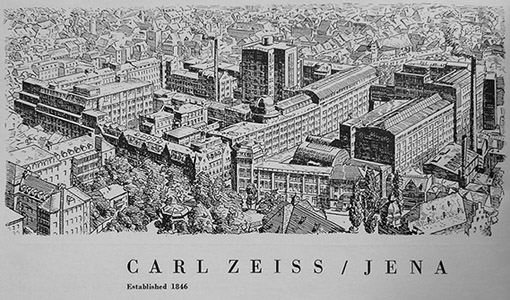
Fig 1.
The Zeiss factories from the book 'Zeiss Microscopes' 1935.
On this point I am awaiting an old Carl Zeiss Jena Stand 'F' fitted with a set of four apochromatic objectives three of which the 10x, 20x and 40x being of the same magnification and aperture to those shown in Fig 11. later in the article. The stand was built in the 1920's but the objectives are of the same design as the 1934 catalogue and this is going to form an article shortly on the comparison between the Zeiss and LOMO optics with pictures side by side showing the similarities between the two and notes on the difference optically [if any] between them. By the late 1930's this stand had lost favour to new designs like the 'L' stand with low slung focus controls and horizontal stage and doesn't appear in the 1937 catalogue.
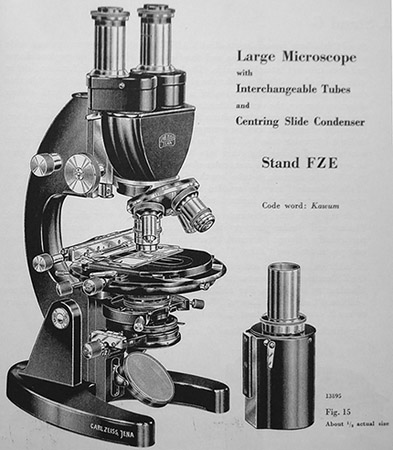
Fig 2.
LOMO remained a rather secretive enterprise for many years after the war not only manufacturing microscopes but also optical equipment for the military. At this point in time I believe the factory based in St. Petersburg still employs thousands of skilled workers not only producing microscopes but many other optical equipments for medical, astronomical and consumer use. The LOMO name remains and a large range of optics is still offered for sale, indeed you can still buy the Biolam in the U.S. now called the Multiscope together with objectives very similar in appearance to those shown in this article but updated in specification to reflect requirements for improved flat field performance. The Multiscope is offered along with more sophisticated and expensive stands with DIN objectives together with microscopes for polarizing and fluorescence work.
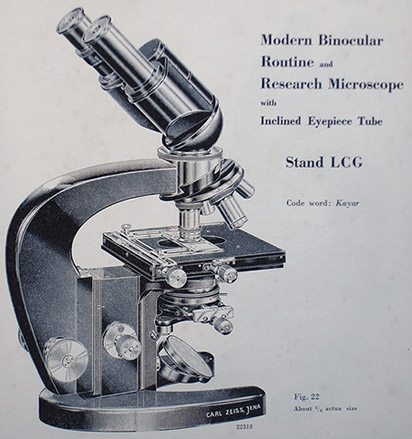
Fig 3.
One version of the Carl Zeiss Stand 'L' 1934, the basic design used for the LOMO Biolam.
The older stands require an external light either by LOMO [not easy to source now except for the overpriced OI-35] or of your own making but I don't consider this a disadvantage since it gives me the flexibility of using different light sources like LED and fluorescent which I like to design and also helps new users of the microscope to go and pick up a good microscopy book and learn a lot more about setting up the lighting compared to a modern stand. At its simplest a good quality 60 watt angle-poise lamp with pearl bulb and shade can provide adequate illumination for most purposes.
It is a moving limb design so more caution has to be used when adding heavier items like the trinocular head or camera attachments so getting the coarse focus friction and lubrication right is important to prevent damage to slides or objectives. This in its right own cannot be called a negative feature since many designs are of this type including the Wild M20 and models from Carl Zeiss and Ernst Leitz from the early 20th century. You could say it is outdated now but LOMO provide higher priced stands with fixed limb if you wish to pay extra but with care and attention to operating practices there is not much to choose between moving stage and moving limb for focusing.
- Plastic rectangular stage with stage clips, this is the simplest and most often seen on ebay.
- Rotating stage with clips or detachable mechanical controls, main components of metal but finished in dense plastic as shown in Fig 5. below.
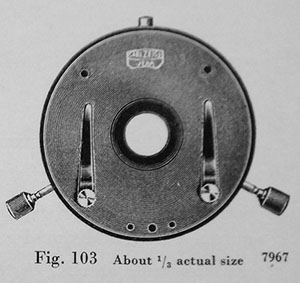
Fig 4.
Zeiss simplified mechanical stage 'A' 1934, similar to Fig 5. below.
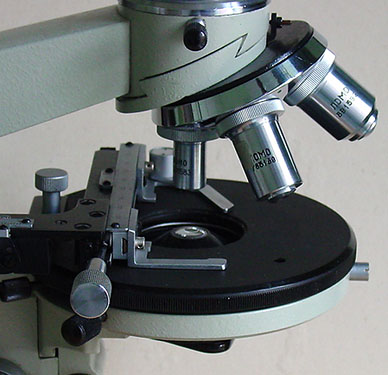
Fig 5.
LOMO rotating stage fitted with mechanical stage control CT-12.
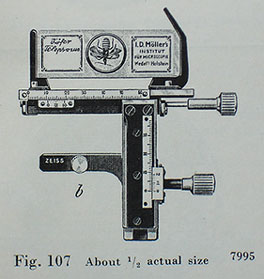
Fig 6.
Zeiss mechanical stage control 1934.
- Large mechanical stage with built in controls based on the design of Zeiss Stage 'E' as shown in Fig 7. these are not so common and fitted to older stands.
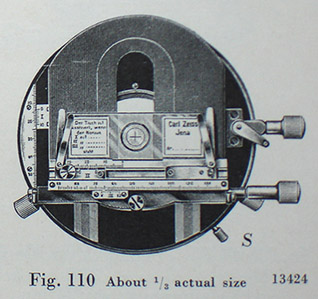
Fig 7.
Original Zeiss large mechanical stage 'E' 1934.
- Modern large rectangular stage with drop down
controls, this is the one typically found on the LOMO stand in the U.S.
- Clock-work or 'base disc' fine focus mechanism depends on age of the stand, the newer ones all use the 'disc', older ones either clock-work or 'disc'.
- Phase contrast set supplied in a wooden box with achromatic phase objectives.
- Aplanatic NA 1.4 condenser with oblique slider control supplied in a wooden box.
- High power dark-field condenser supplied in wooden box matches specific objectives from the LOMO range.
- Monocular vertical/inclined, binocular, trinocular and photographic heads with photo eyepieces.
- A large selection of pre DIN achromatic and apochromatic objectives [use with compensating eyepieces] derived from the original Zeiss Jena designs.
Most of these options are still available either new from outlets in Germany / U.S. or in small quantities from RAF Camera or eBay, you may have to wait a while but they will turn up. The latest stand also has built in 20 Watt halogen illumination. So we can see from this list we can have bright-field, dark-field [low and high power], phase contrast and with some simple home made accessories Rheinberg and polarized light microscopy... not bad for a modest stand. There is even specialized fluorescence and epi-illumination options on the modern stand. More importantly most of these options are quite affordable after you purchase the stand especially if you buy used, compare this to some of the prices you may have to pay to get apochromatic objectives or aplanatic condenser from Leica or Olympus for instance.
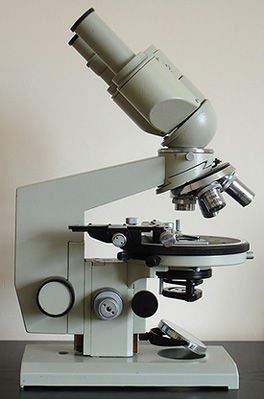
Fig 8.
LOMO Biolam with binocular head and Abbe condenser from the late 1970's.
In contrast to the rather utilitarian paint finish the mechanics lurking within the stand are very good with solid castings and engineering with few plastic parts critical in the construction to crack or break over the years. Where plastic is used in the condenser height control for instance it is because the action should be of a light and delicate nature not requiring sufficient force to require larger brass fittings. The older clock-work fine focus mechanisms being embedded well within the body of the stand usually doesn't cause any problems and our two stands are free from any undue play or back-lash. If you have to work on it and I think this is based on the same mechanism as the Zeiss Jena stand 'L' is after cleaning any debris or grease that shouldn't be in the mechanism anyway is to use no lubrication on any of the small delicate cogs and teeth, they should run dry.
Here is a list of the objectives my brother has, the numerical apertures not listed are standard for the type, the machining and finish are uniformly excellent:
3.5x plan, 8x, 9x, 20x, 40x, 40x NA 0.75 and 85x NA 1.0 water immersions, the latter with correction collar and 90x oil immersion achromats.
10x NA 0.3, 20x, 40x and 90x phase achromats but not shown in the pictures since they have very similar appearance to the standard achromat range.
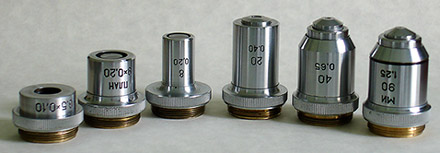
Fig 9.
Typical LOMO achromatic objectives, the 40x NA 0.65 is the best achromat in this standard numerical aperture I have come across.
Only a few weeks ago tests were done with the achromatic 90x oil immersion with the aplanatic condenser 'watered-up' to the bottom of the slide with a strew of the diatom Amphipleura pellucida mounted in sirax comparing this with the Zeiss Photomic III with achromatic-aplanatic NA 1.4 condenser oiled to the slide using a Zeiss 100x NA 1.25 achromat and phase neofluar NA 1.30 objectives the scopes being side by side. The test was interesting in that the humble LOMO setup provided an excellent account of itself with markings of the diatom clearly shown with a modest amount of oblique illumination and produced little in the way of residual colour from the objective producing a clear and most satisfying image. On the other hand the image from the Zeiss phase Neofluar in brightfield with oblique illumination created a rather unpleasant colour caste on the markings of green-purple [depending on focus] and was considered unsatisfactory whilst the 100x achromat was deemed satisfactory. The 'X' 'Y' controls on our mechanical stage are a little 'jumpy' on the LOMO at 1000x and above magnification but still perfectly usable whilst the Zeiss Photomic stage controls were smoother but no means faultless.
Of the objectives running in phase contrast my favourite is the 10x NA 0.3 which gives a bright crisp image whilst looking at pond samples and gives particularly pleasing images on common subjects like spirogyra, the others are competent but not in the same class as Wild's phase fluotars with high numerical aperture which really excel in this area, the Wild 10x NA 0.45 and 20x NA 0.60 could hardly be bettered in this respect provided field flatness is of no concern to the user.
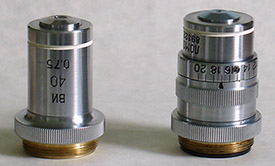
Fig 10.
40x NA 0.75 and 85x NA 1.0 water immersion objectives, 85x let down by stiff collar on our sample making it difficult to use.
The 85x NA 1.0 WI on the other hand is an objective to use when you wish to avoid oiling slides providing good detail and contrast on most diatom structures however its correction collar is very stiff [typical for LOMO] and so the tendency is to leave it set on 0.17mm and use modern preparations where cover slips are of more uniform thickness. I still think the 90x NA 1.25 oil immersion is the better objective giving crisper and better definition to more difficult subjects and is very forgiving of Victorian slides.
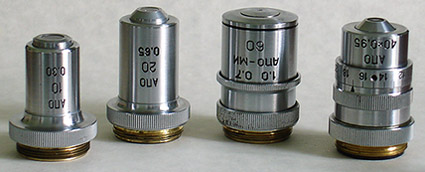
Fig 11.
10x NA 0.3, 20x NA 0.65, 60x NA 0.7-1.0 diaphragm [DF], 40x NA 0.95 [CC].
Now to my favourites the apochromatics. All our samples are optically excellent my favourites being the 20x NA 0.65 and 40x NA 0.95 these would normally be used with compensating eyepieces marked on the LOMO as 7K or 10K etc for residual colour correction. The 20x gives superb dark-field results on my old brass scope with the supplied stop providing very bright subjects on a velvety black background unobtainable on a lot of older achromatic objectives which can give a 'foggy' appearance for this magnification. With its high NA it also gives a real crispness to bright-field subjects and needs higher power eyepieces to reveal hidden detail not seen with the 7x eyepieces.
The 40x NA 0.95 can give stunning results on modern slide preparations but is let down by the correction collar which runs very stiff indeed in colder weather due to hardened grease but I often use this on my Edwardian scope fitted with its rack and pinion monocular tube so I can correct for different cover thickness by tube length rather than correction collar which I find more convenient anyway leaving the correction set to 0.17mm on the objective. As with objectives from any manufacturer producing them in large quantities there will be variations in output so there is the possibility of an occasional poor sample something I have noted with more modern Zeiss 40x achromatic objectives which from my samples both for 160mm and infinity corrected seem to under perform.
A mention must be made also of the 60x NA 0.7-1.0 with internal diaphragm. This objective has been specially made for the high power dark-field condenser but with diaphragm set to 1.0 it gives excellent results in bright-field and is a nice intermediate power between the 40x dry and 90x oil immersion objectives. I am awaiting the original Zeiss Jena dark-field condenser for my Zeiss microscope which I hope will be cross-platform and also fit the LOMO stand. I will possibly write an article in the future on the results obtained and some sample images.
The LOMO apochromatic objectives are based on early 20th century Zeiss designs, good field flatness could not be achieved only at the expense of reducing aperture which in those days was deemed totally unacceptable for apochromatics the highest numerical apertures always being strived for.
The LOMO aplanatic condenser.
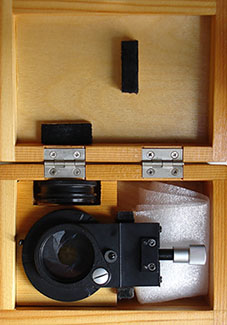
Fig 12.
Aplanatic NA 1.4 oblique condenser with alternative NA 0.3 top element above.
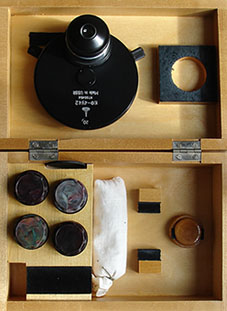
Fig 13.
The phase telescope fits in the velvet lined slot at the bottom and not shown.
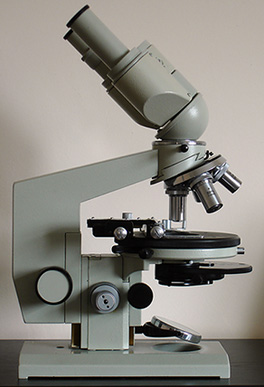
Fig 14.
Phase condenser in position on the microscope with phase objectives on the turret.
Compare this to phase condensers from Zeiss like the one shown on the right in Fig 15. which have had phase rings come off from the glass, seized diaphragms [grease] and very stiff rotation [grease], each one I have owned has needed work doing on them before being usable. A much more modern Zeiss aplanatic-achromatic condenser that my brother bought recently had top glass elements full of oil, considering its specifically designed for oil immersion suggests the seal was not very good and since it was sold as checked and working.... buyer beware.
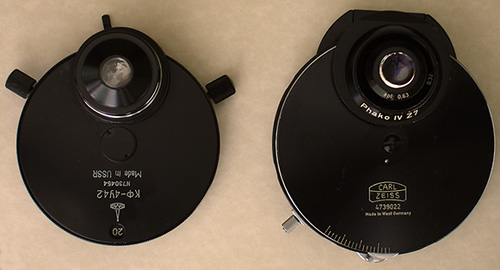
Fig 15.
Comparison between LOMO and an old Zeiss aplanatic NA 0.63 LWD phase condenser.
Tube options.
The simple vertical tube has no optics of its own and can be used with or without an eyepiece being mainly used with video or still cameras.
The trinocular attachment shown in Fig 16. with built in magnification changer and Bertrand lens position is rather bulky and heavy and I personally think unbalances the stand - the whole thing becoming rather unwieldy, although Dave bought an old second hand one to try some time ago it has had little use preferring the simple vertical tube and a camera setup like the Sony S75 digital camera with T2 attachment to accept an eyepiece and Nikon reversed lens.
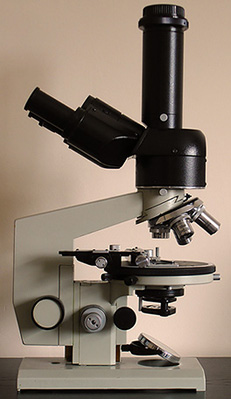
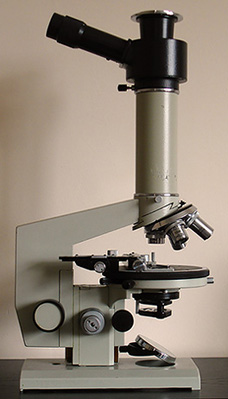
Fig 16. and Fig 17.
LOMO trinocular and photographic attachments.
The monocular photo attachment shown in Fig 17. is much lighter than the trinocular head and has an angled focusing eyepiece tube to obtain parfocality with the vertical attachment to take T2 mounts etc but in the old days was primarily designed for the Zenith camera back. Again, an old second hand one was bought some time ago but the fit and finish on our sample doesn't seem to be as good as the rest of the LOMO accessories and is rather crude.
On used microscopes, gains and pitfalls.
These notes are from personal experience, you may have very different views.
Zeiss sadly there is a nasty affliction going on in eBay recently were some sellers are reducing good complete stands to boxes of disembowelled parts to squeeze the last few dollars out of buyers; this means fewer and fewer good stands will be available for microscopists in the future.
Zeiss between the 1960's and 1970's produced thousands of objectives that are now delaminating. This of course does not include DIC prisms, sliders and polarizers afflicted with the same problem. I have yet to see a LOMO objective that has delaminated.
Zeiss made phase rings for their older condensers that had a tendency to flake or fall off.
LOMO is not alone in the grease problem, I have found Zeiss condenser and field diaphragms seized, phase condenser mechanics seized and correction collars on objectives very stiff and difficult to operate.
Wild used plastic for some of the cogs in their mechanical stages which may crack as they grow older with spares not easy to obtain and the stands themselves are not as straightforward to work on being a more complex design than LOMO.
Nikon used plastic gears in some of their old microscopes and these also had a tendency to crack, be broken by careless use or wear out, buy one of these stands and you may have trouble getting it repaired.
In the secondhand market the point I am trying to make is just because it's called Zeiss or Wild etc, the names we are supposed to trust for quality and reliability don't expect a trouble free ride when the delivery man knocks on your door with your microscope.
Do I hear the word 'dealer' being mentioned? Buy from a dealer, they check everything before dispatch right and sell you a nice working microscope. Well, yes and no from my experience, I have had some very good equipment from dealers both in the U.K. and abroad but I have also come across optics and mechanics that should have been checked more thoroughly before dispatch together with packing of items which has been very poor on occasion and you still have the problem of sorting it out especially if ordered from overseas.
So now we come full circle back to the LOMO Biolam. A stand which you can easily work on without detailed drawings learning about the microscope as you go along together with engineering of brass and aluminium. One which you can make simple parts for yourself and a system that is still supported after all these years with objectives and accessories. I have used and refurbished a good number of different scopes spanning 150 years from early Victorian to modern Leica and Zeiss infinity but the Biolam has stood the test of time, enough said.